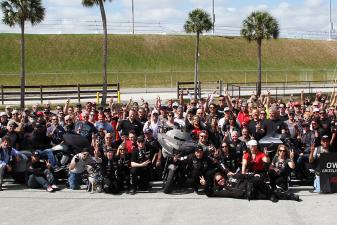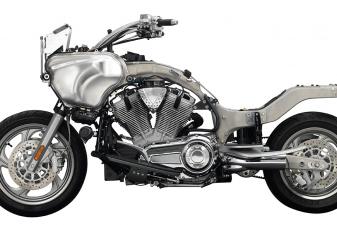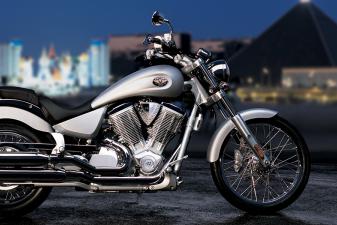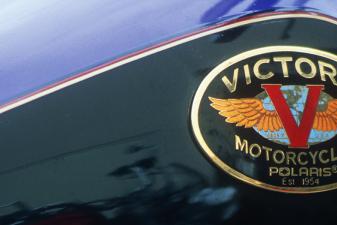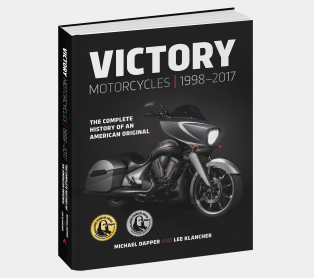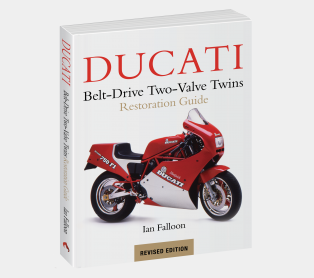Sculpting the Victory CORE Concept Motorcycle
By Michael Dapper

Victory Motorcycles 1998–2017 author Michael Dapper chronicles development of the CORE Concept Bike—from its inception as pencil scribbles on scratch paper to its development via CAD drawings, clay models, and metal casting. Senior Industrial Designer Mike Song and Operations Manager Ryan Andreae weigh in on their experience creating—and riding—the machine. Though the bike was far too raw to become a production model, elements of the concept can be seen in the brand’s subsequent model, the Octane. Find more stories of Victory Motorcycles development, testing, and brand history on the Octane Press FUEL Blog.
Take your choice of adjectives to describe the Victory CORE concept bike: efficient, innovative, stylish, sturdy, sporty, spare—and don’t forget award-winning. Introduced at the motorcycle show in New York City in January 2009, the CORE was a no-frills concept whose name reflected that the bike was nothing more than the core elements of a motorcycle: frame, wheels, engine. Period.
In 2008, Victory Senior Industrial Designer Mike Song considered the many purposes served by the front piece of the Victory Vision frame, and he started to sketch a bike with a minimalistic frame that provided maximum versatility. He blended in style elements of a traditional bobber, and the CORE was born—on paper.
Greg Brew, now vice president of industrial design (ID), saw Song’s sketches and insisted that they turn the idea into reality. More-detailed artwork was created, along with a clay model and CAD (computer-aided design) drawings of the bike.
To really optimize the utility of the main frame piece, the ID team and Victory engineers decided to have it built with metal castings rather than the traditional welding and fabrication processes. That created (at least) one problem: It was already late November 2008, and the bike was scheduled to debut in January 2009.
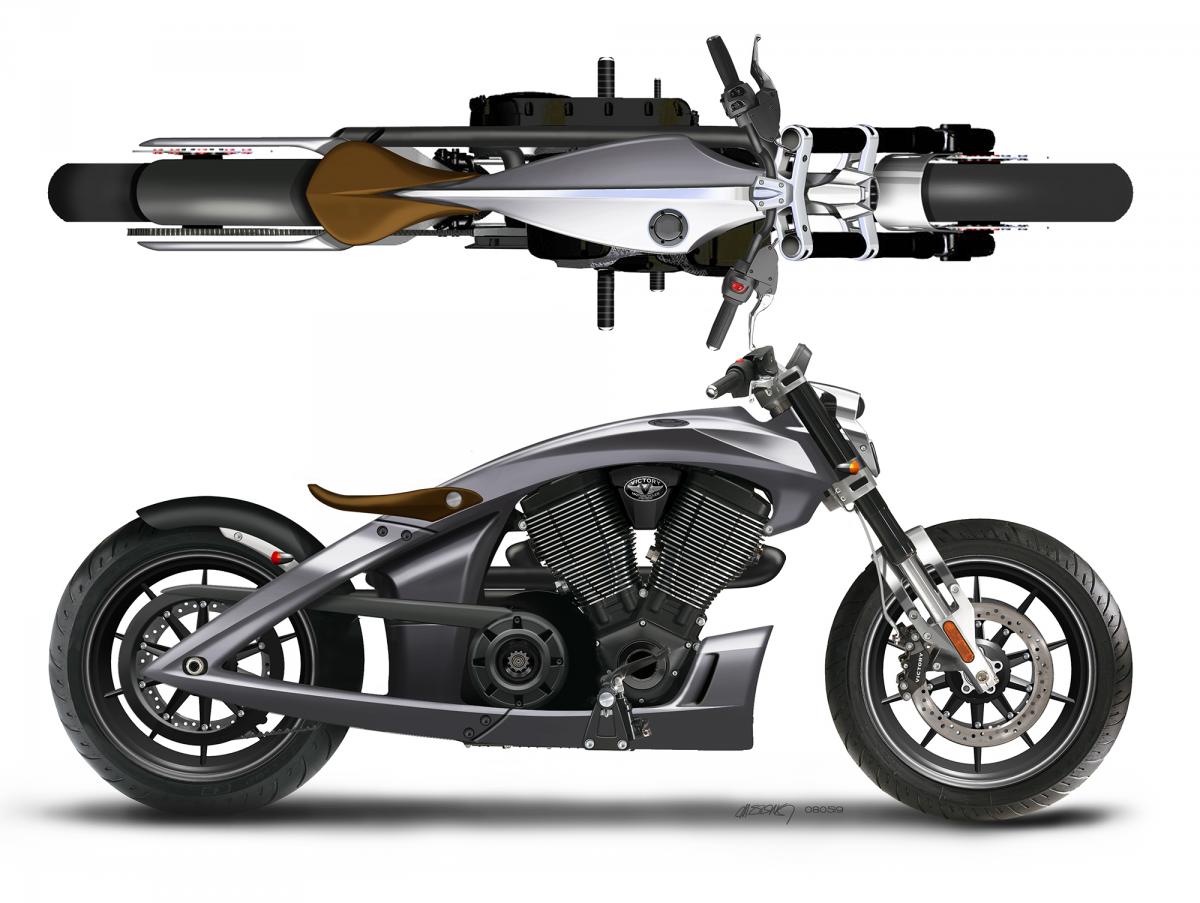 Inspired by the two-piece cast aluminum frame of the Vision, Senior Industrial Designer Mike Song started drawing a very spare, no-frills motorcycle. The art evolved to these concepts of CORE, which is no more than wheels, an engine, and a minimalistic frame. Mike Song
Inspired by the two-piece cast aluminum frame of the Vision, Senior Industrial Designer Mike Song started drawing a very spare, no-frills motorcycle. The art evolved to these concepts of CORE, which is no more than wheels, an engine, and a minimalistic frame. Mike Song
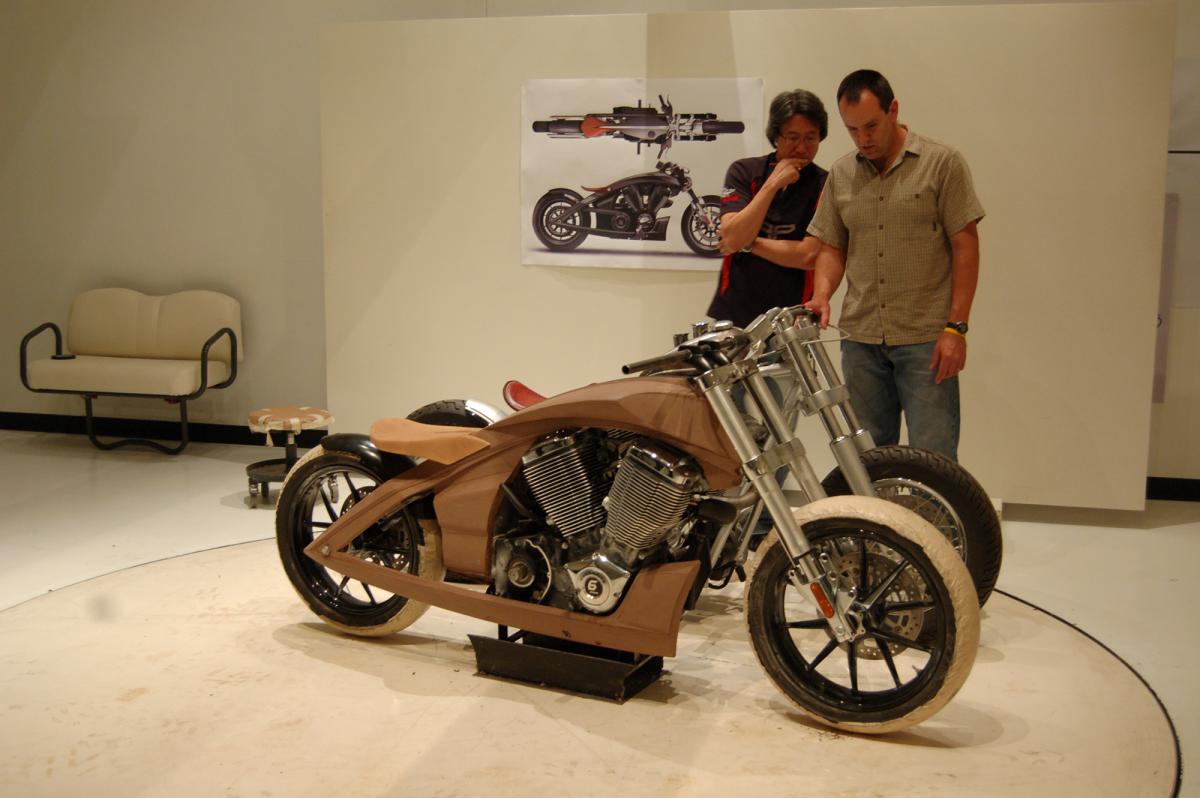 Senior Industrial Designer Mike Song (left) and now-VP Industrial Design Greg Brew compare the clay model of the CORE (nearest the camera) with Brew’s personal no-frills Victory custom. Mike Song
Senior Industrial Designer Mike Song (left) and now-VP Industrial Design Greg Brew compare the clay model of the CORE (nearest the camera) with Brew’s personal no-frills Victory custom. Mike Song
No problem, said the staff at Craft Pattern and Mold in Maple Plain, Minnesota. They worked—quickly—with the Victory team and created the CORE’s five-piece frame using a no-bake sand molding process. Wax versions of the frame pieces were set in wet sand to create the molds (two complete CORE frames were cast), and then molten aluminum was poured into the molds. The metal set quickly and project participants took turns swinging sledge hammers to break away the hardened sand molds.
Once removed from the molds, the 356 aluminum was tempered with T-6 heat treatment, and most surfaces were left with an organic, as-cast finish. Exceptions to this raw finish were a top spine running the length of the main frame piece, which was polished smooth for style, and contact surfaces where frame pieces connected to one another or to other components. (The finished bike also featured stripes and graphic accents hand-painted by the ID team’s Steve Leszinski.)
The Victory team needed an assembly site and some fabrication capabilities, so they teamed up with professional Polaris ATV racer Daryl Rath. CORE was assembled at Rath Racing, Rath’s Hutchinson, Minnesota, race shop and performance company, and he fabricated the bike’s custom exhaust.
ID team members like Brew, Song, and Ryan Andreae (the ID operations manager at the time) spent countless hours in December 2008 at Rath’s shop. They finished assembling CORE in early January 2009, shot photos of the bike at a Minneapolis studio on Jan. 11, and then shipped the bike to New York, where it was unveiled to rave reviews on Jan. 16.
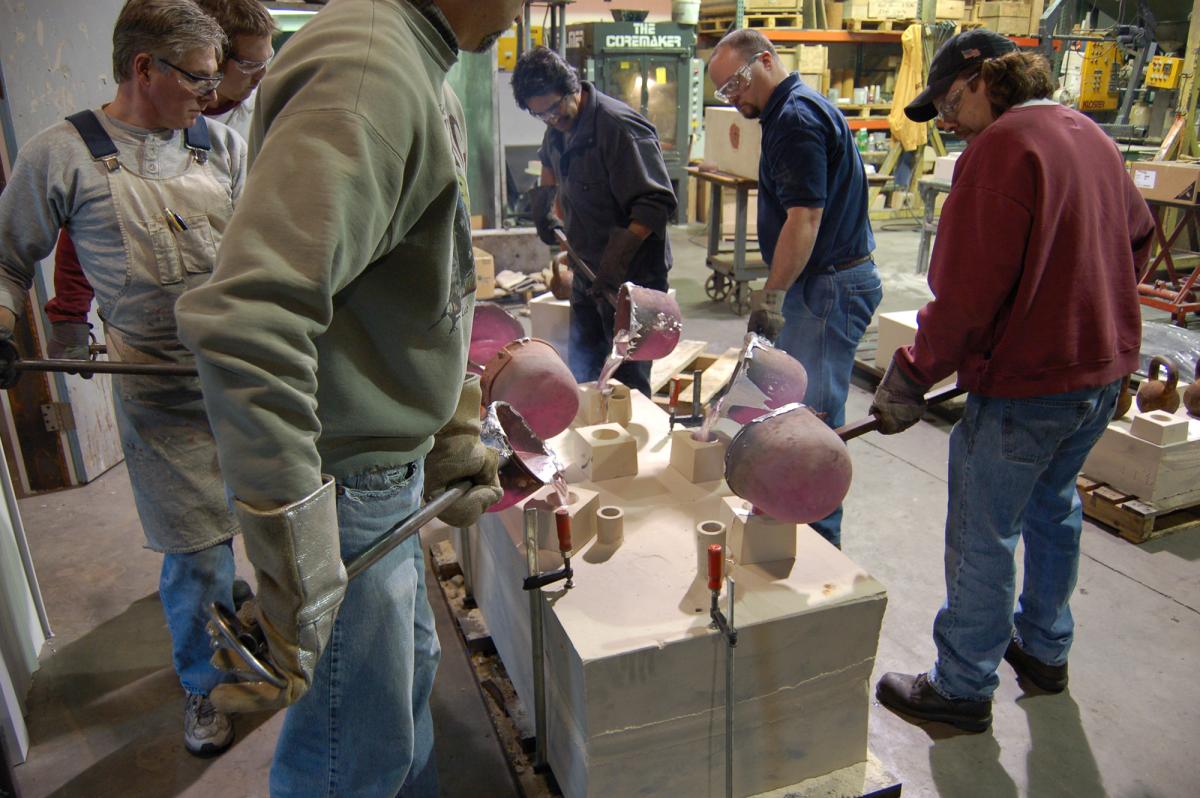 Molten aluminum is poured into a sand-cast mold to create the five-piece frame of CORE. The bike was created from tempered aluminum 356-T6. The completed bike weighed just 469 pounds and was powered by the same Freedom 106/6 engine that powered Victory models such as the 850-pound (dry) Vision. Victory
Molten aluminum is poured into a sand-cast mold to create the five-piece frame of CORE. The bike was created from tempered aluminum 356-T6. The completed bike weighed just 469 pounds and was powered by the same Freedom 106/6 engine that powered Victory models such as the 850-pound (dry) Vision. Victory
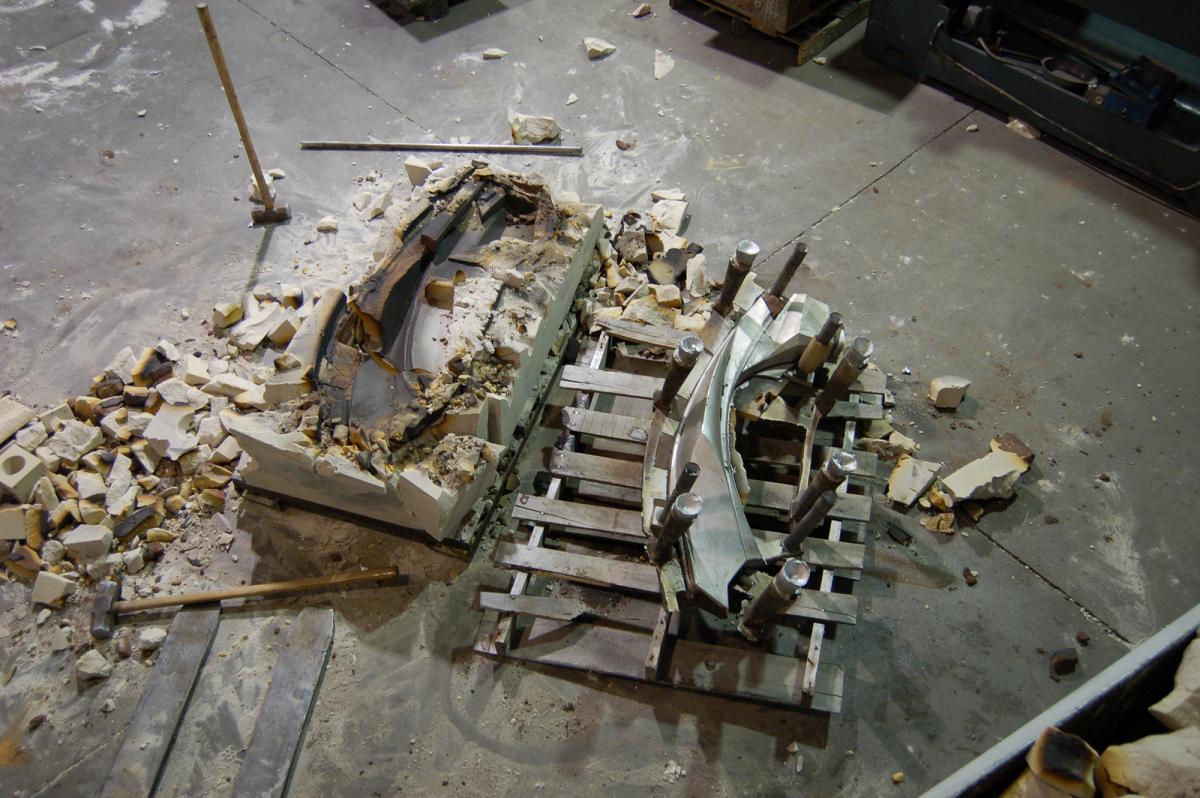 Using sledge hammers, the build team broke apart the sand-cast mold (left) to access the cast aluminum frame components (on pallet). The main frame piece seen here stretched from the triple trees to the seat. It had an integrated 3.25-gallon fuel tank and served as the engine’s mounting point. Victory
Using sledge hammers, the build team broke apart the sand-cast mold (left) to access the cast aluminum frame components (on pallet). The main frame piece seen here stretched from the triple trees to the seat. It had an integrated 3.25-gallon fuel tank and served as the engine’s mounting point. Victory
Components and Design
CORE’s main frame piece extends from the steering head back to the seat, and it serves several purposes. It contains the gas tank and air intake, hosts much of the wiring harness, and serves as the mounting points for the steering head, engine, and seat. The piece weighs just 51 pounds, yet it is extremely strong. It’s so impressive that for this single piece, Craft Pattern and Mold won the 2009 Casting of the Year award from Metal Casting Design & Purchasing magazine and the American Foundry Society.
The front section of this main frame piece is the air intake, and the fuel is housed in the rear section of the piece that extends downward, under the seat. Below the fuel tank and just in front of the rear wheel is the battery box, and the frame piece extending forward from the battery box houses the oil cooler.
The bike is extremely narrow, thanks in part to a custom drive belt made by Gates that is only about one inch wide. To host this belt, a stock Victory rear sprocket was cut thinner, and then a side ring was re-attached.
The African mahogany seat is mounted on a carbon fiber base plate, and the triple trees are made of billet. Why a wooden seat? “Because the bike is a sculpture,” said Song, who hand-styled foam to create the original seat design. He said he drew a version the bike with a rear suspension, “but Greg [Brew] said it had to be a hard tail because the entire bike was a sculpture.”
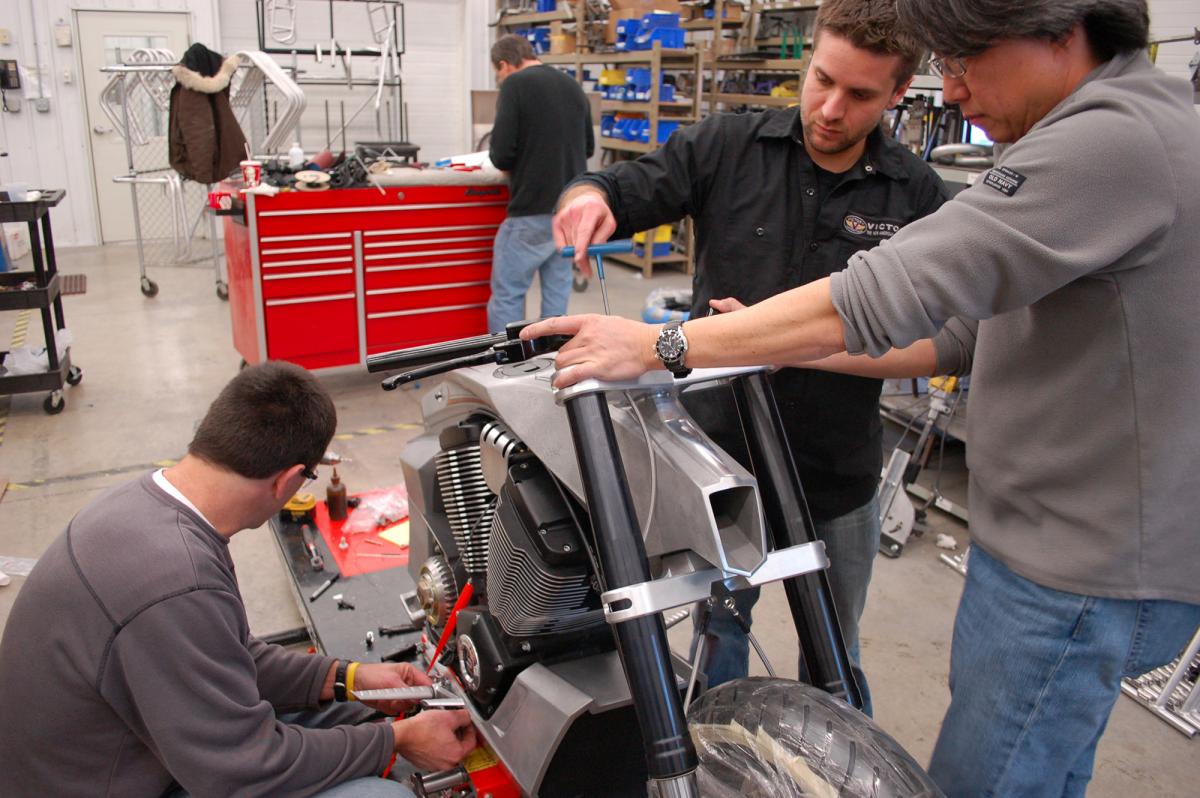 Senior Industrial Designer Mike Song (far right) and Industrial Design Operations Manager Ryan Andreae (next to Song) attached the handlebar to CORE during the bike’s assembly at the Rath Racing shop in Hutchinson, Minnesota. Victory
Senior Industrial Designer Mike Song (far right) and Industrial Design Operations Manager Ryan Andreae (next to Song) attached the handlebar to CORE during the bike’s assembly at the Rath Racing shop in Hutchinson, Minnesota. Victory
Ride It Hard
CORE was displayed at a few early 2009 bike shows, then was returned to Minnesota, where the ID team took the final steps to make it a runner. They brought it to the 2009 Sturgis rally not to display it, but to ride the wheels off it.
“We rode it hard,” Song recalled.
“It hauls,” Andreae laughed. “We didn’t baby it. there was one night we were riding to our house, which was on a gravel road, and we were dirt-tracking through the turns.”
“I do remember riding it on the freeway, and with that hard tail, it was so rough, I was wondering how people do that,” Song said.
CORE was too raw and minimal to become a true production model, but elements of the bike live on in the Victory Octane. Today, CORE is in Polaris storage somewhere, and the second frame’s location is unknown.
“Somebody’s got a second CORE,” Andreae laughed.
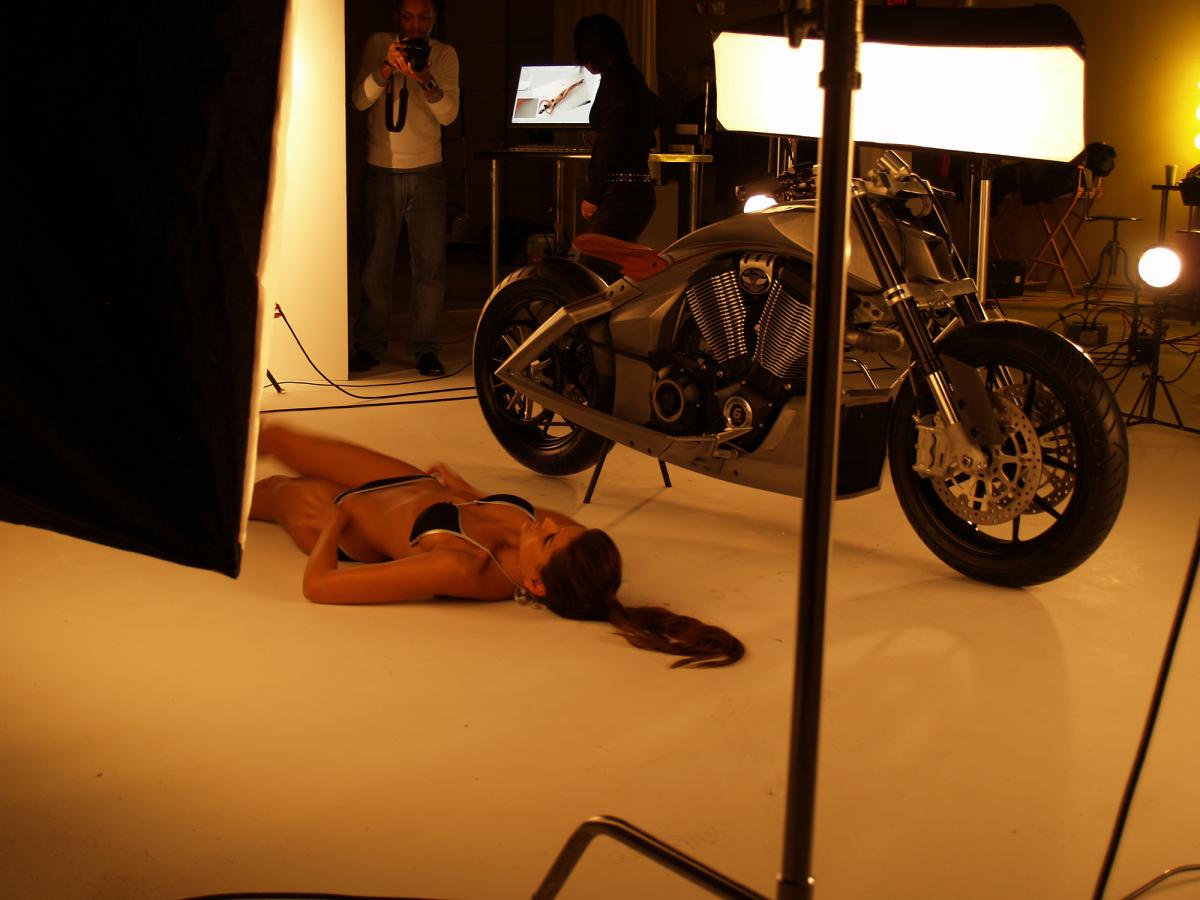 A bikini-clad Florida fashion model got used to the freezing-cold concrete floor of a Northeast Minneapolis photo studio on Sunday, Jan. 11, 2009. The model posed on the floor for photos shot from above the bike. After removing a robe, the model screamed when she got down on the floor, which was plenty cold on a day when the high temperature in Minneapolis was 17° above Fahrenheit. Michael Dapper
A bikini-clad Florida fashion model got used to the freezing-cold concrete floor of a Northeast Minneapolis photo studio on Sunday, Jan. 11, 2009. The model posed on the floor for photos shot from above the bike. After removing a robe, the model screamed when she got down on the floor, which was plenty cold on a day when the high temperature in Minneapolis was 17° above Fahrenheit. Michael Dapper
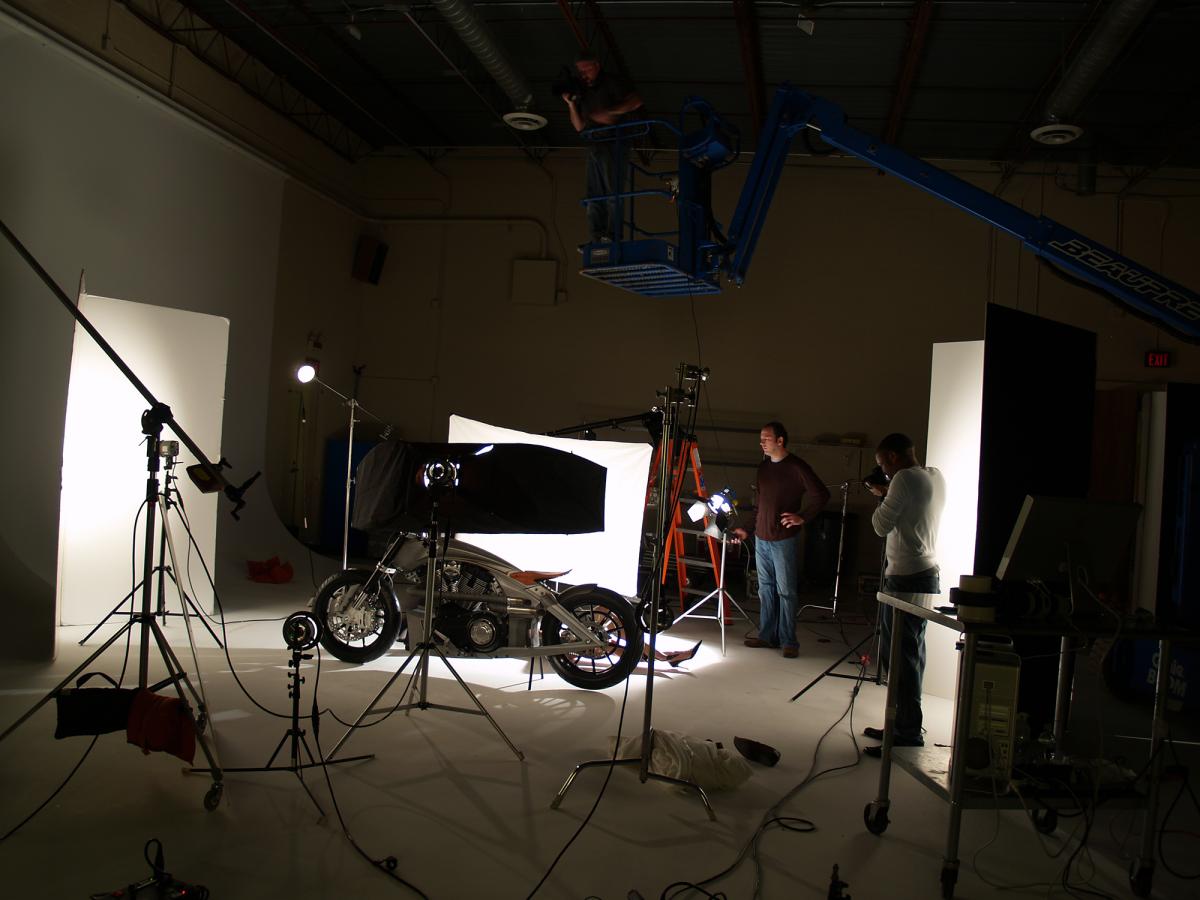 Here’s the Northeast Minneapolis photo studio where CORE was photographed one week before its debut in New York City. You can see a photographer on a lift directly above the bike, and extending beyond the rear wheel are the legs and stiletto heels of a Florida fashion model posed on the floor next to the bike. Michael Dapper
Here’s the Northeast Minneapolis photo studio where CORE was photographed one week before its debut in New York City. You can see a photographer on a lift directly above the bike, and extending beyond the rear wheel are the legs and stiletto heels of a Florida fashion model posed on the floor next to the bike. Michael Dapper
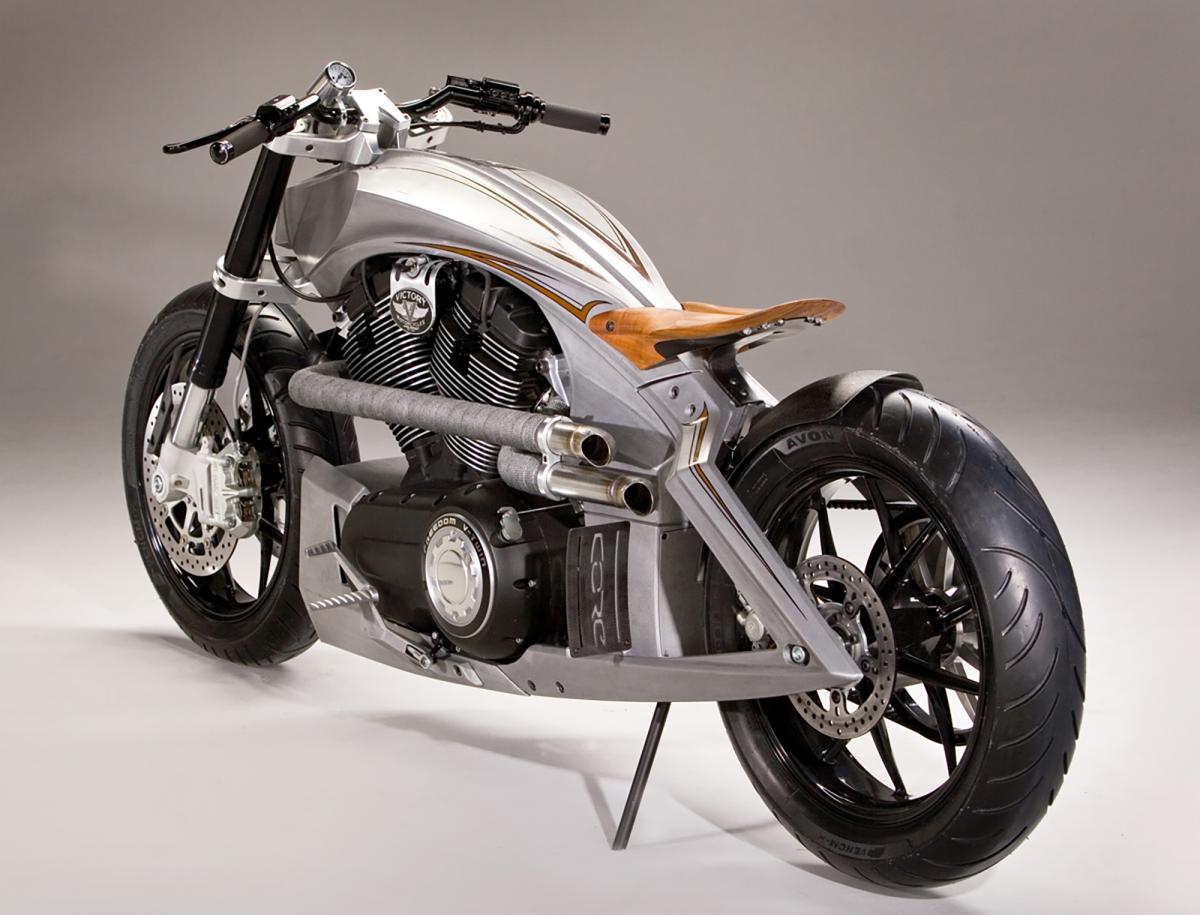 This view shows the bike’s straight exhaust and its rear–oh wait–there is no rear suspension on this rigid frame. A suspension would require components, which would add weight, so CORE was built with a solid tail. Victory
This view shows the bike’s straight exhaust and its rear–oh wait–there is no rear suspension on this rigid frame. A suspension would require components, which would add weight, so CORE was built with a solid tail. Victory
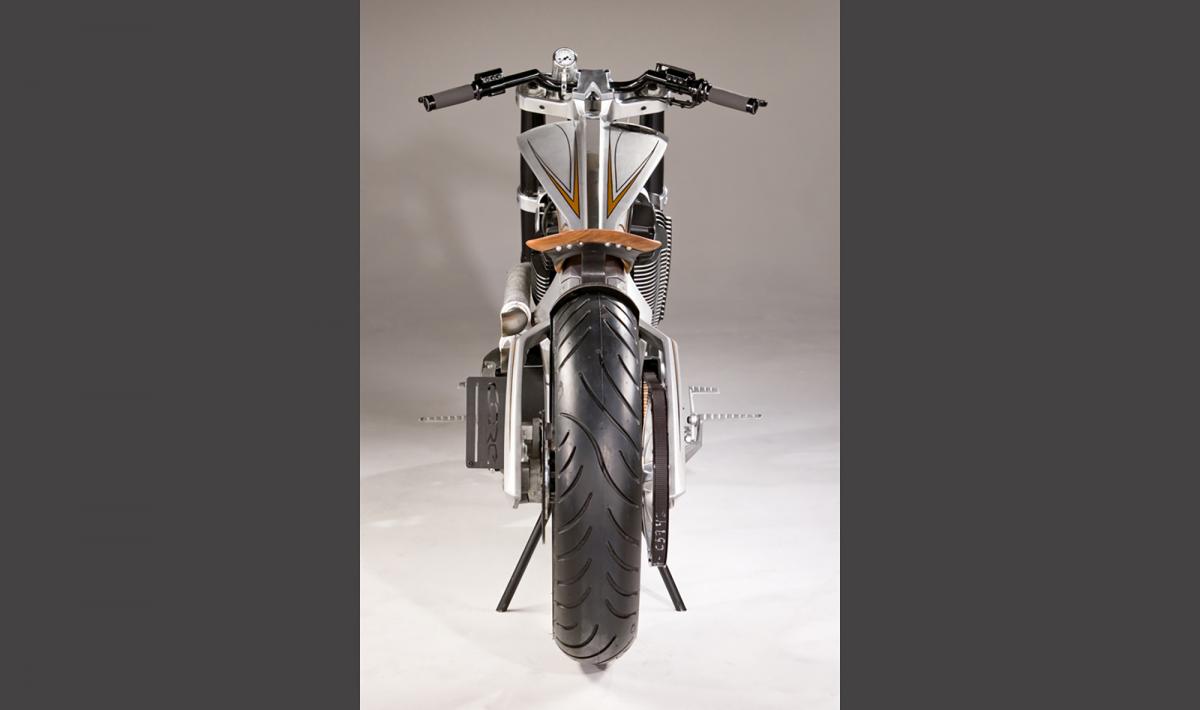 Lean and mean, that was CORE. This view from directly behind the bike shows how thin a bike can be with no bodywork, a minute fuel tank, and no frills. The taillights and rear turn signals are integrated in the base of the African mahogany seat, and the frame is built tight to the right-side belt drive and rear wheel’s left-side brake. Victory
Lean and mean, that was CORE. This view from directly behind the bike shows how thin a bike can be with no bodywork, a minute fuel tank, and no frills. The taillights and rear turn signals are integrated in the base of the African mahogany seat, and the frame is built tight to the right-side belt drive and rear wheel’s left-side brake. Victory
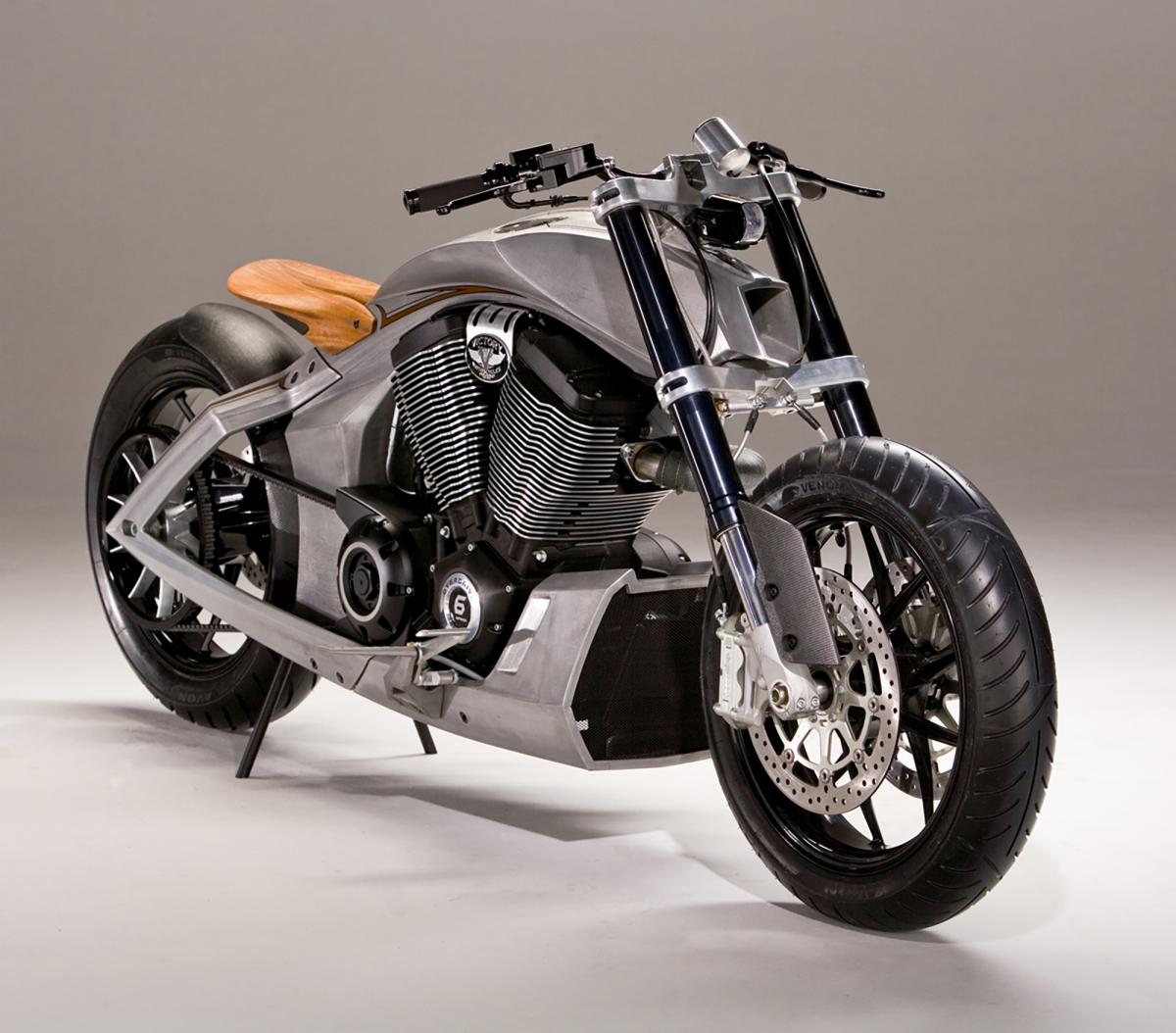 If it didn’t serve a purpose, it was not installed on this bike. There’s a versatile five-piece frame, wheels, and a powerful engine–and that’s it. The Industrial Design team got the bike running and made it mostly legal, and then brought it to the Black Hills for some riding and Badlands photography during a Sturgis motorcycle rally. Victory
If it didn’t serve a purpose, it was not installed on this bike. There’s a versatile five-piece frame, wheels, and a powerful engine–and that’s it. The Industrial Design team got the bike running and made it mostly legal, and then brought it to the Black Hills for some riding and Badlands photography during a Sturgis motorcycle rally. Victory
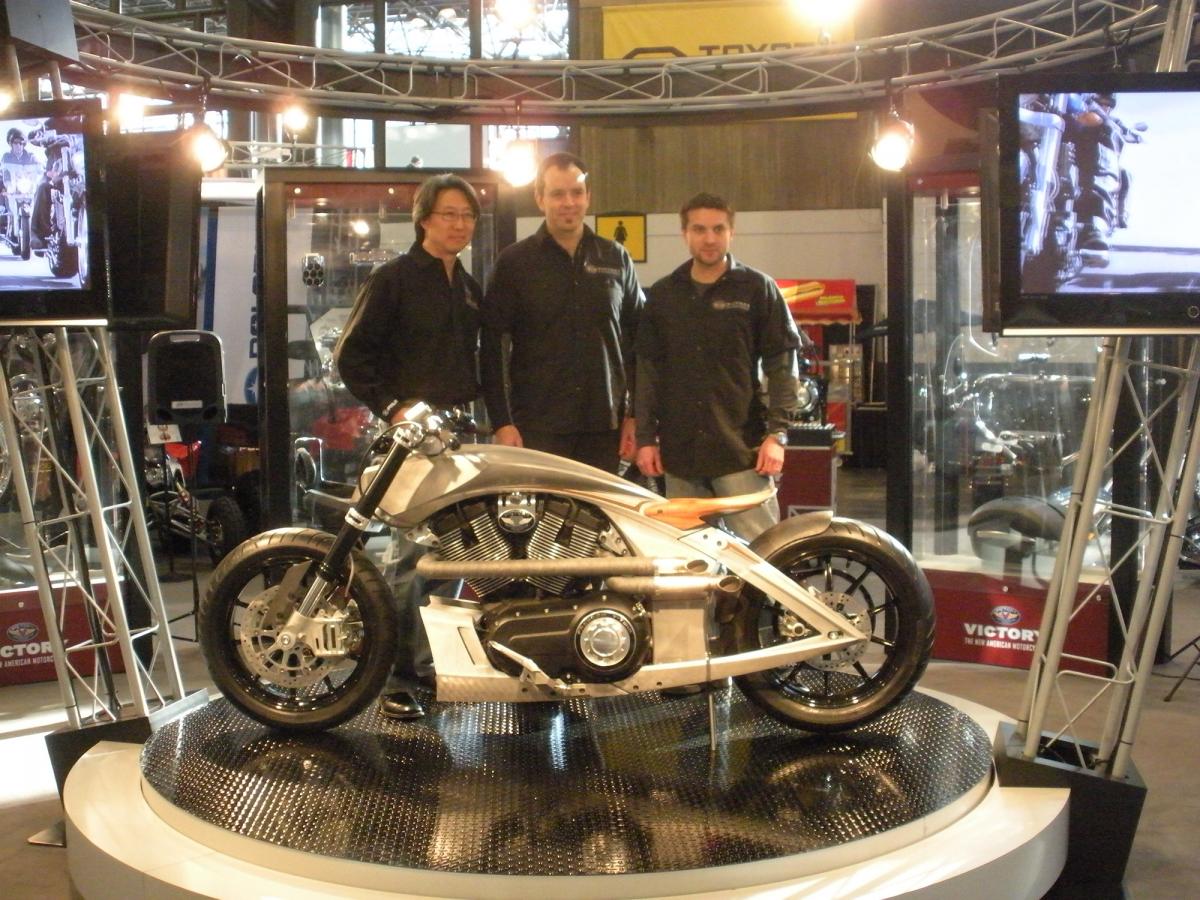 CORE made its public debut on Jan. 16, 2009, at the motorcycle show in New York City. Shown with the bike at that show are the key members of the Industrial Design team who shepherded the bike through its creation (l-r): Mike Song, Greg Brew, and Ryan Andreae. Victory
CORE made its public debut on Jan. 16, 2009, at the motorcycle show in New York City. Shown with the bike at that show are the key members of the Industrial Design team who shepherded the bike through its creation (l-r): Mike Song, Greg Brew, and Ryan Andreae. Victory
See the video Victory produced for the CORE introduction, below:
(https://bit.ly/2GVJbEW)
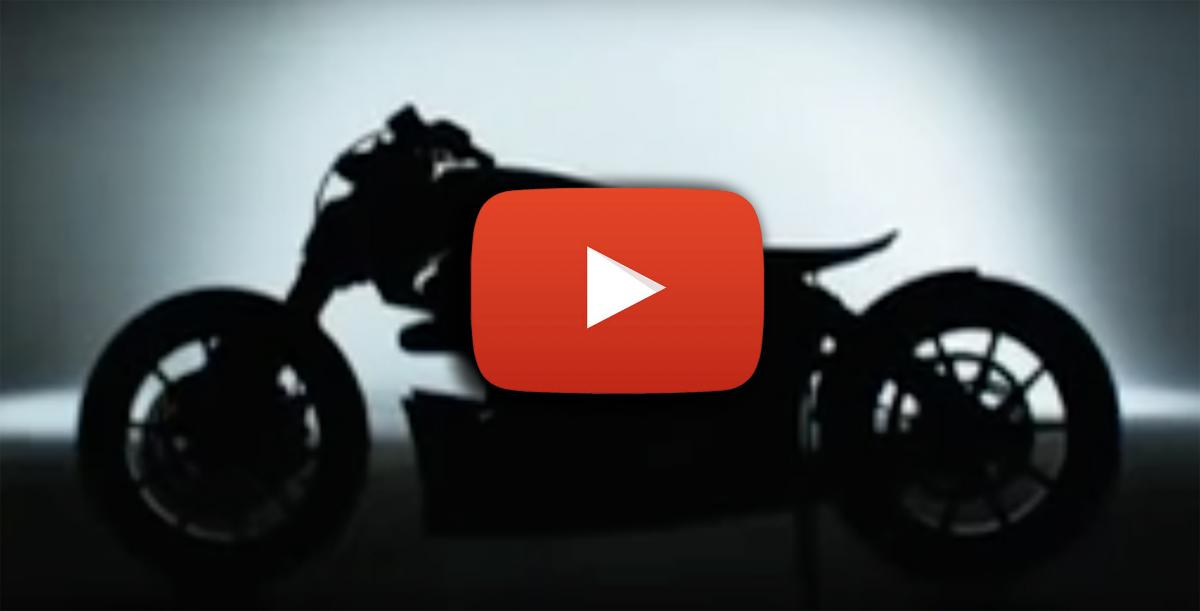
Special thanks to Ryan Andreae and Mike Song for their help on this article.
Find more stories of Victory Motorcycles development, testing, and brand history on the Octane Press FUEL Blog.
Take your choice of adjectives to describe the Victory CORE concept bike: efficient, innovative, stylish, sturdy, sporty, spare—and don’t forget award-winning. Introduced at the motorcycle show in New York City in January 2009, the CORE was a no-frills concept whose name reflected that the bike was nothing more than the core elements of a motorcycle: frame, wheels, engine. Period.
In 2008, Victory Senior Industrial Designer Mike Song considered the many purposes served by the front piece of the Victory Vision frame, and he started to sketch a bike with a minimalistic frame that provided maximum versatility. He blended in style elements of a traditional bobber, and the CORE was born—on paper.
Greg Brew, now vice president of industrial design (ID), saw Song’s sketches and insisted that they turn the idea into reality. More-detailed artwork was created, along with a clay model and CAD (computer-aided design) drawings of the bike.
To really optimize the utility of the main frame piece, the ID team and Victory engineers decided to have it built with metal castings rather than the traditional welding and fabrication processes. That created (at least) one problem: It was already late November 2008, and the bike was scheduled to debut in January 2009.
 Inspired by the two-piece cast aluminum frame of the Vision, Senior Industrial Designer Mike Song started drawing a very spare, no-frills motorcycle. The art evolved to these concepts of CORE, which is no more than wheels, an engine, and a minimalistic frame. Mike Song
Inspired by the two-piece cast aluminum frame of the Vision, Senior Industrial Designer Mike Song started drawing a very spare, no-frills motorcycle. The art evolved to these concepts of CORE, which is no more than wheels, an engine, and a minimalistic frame. Mike Song Senior Industrial Designer Mike Song (left) and now-VP Industrial Design Greg Brew compare the clay model of the CORE (nearest the camera) with Brew’s personal no-frills Victory custom. Mike Song
Senior Industrial Designer Mike Song (left) and now-VP Industrial Design Greg Brew compare the clay model of the CORE (nearest the camera) with Brew’s personal no-frills Victory custom. Mike SongNo problem, said the staff at Craft Pattern and Mold in Maple Plain, Minnesota. They worked—quickly—with the Victory team and created the CORE’s five-piece frame using a no-bake sand molding process. Wax versions of the frame pieces were set in wet sand to create the molds (two complete CORE frames were cast), and then molten aluminum was poured into the molds. The metal set quickly and project participants took turns swinging sledge hammers to break away the hardened sand molds.
Once removed from the molds, the 356 aluminum was tempered with T-6 heat treatment, and most surfaces were left with an organic, as-cast finish. Exceptions to this raw finish were a top spine running the length of the main frame piece, which was polished smooth for style, and contact surfaces where frame pieces connected to one another or to other components. (The finished bike also featured stripes and graphic accents hand-painted by the ID team’s Steve Leszinski.)
The Victory team needed an assembly site and some fabrication capabilities, so they teamed up with professional Polaris ATV racer Daryl Rath. CORE was assembled at Rath Racing, Rath’s Hutchinson, Minnesota, race shop and performance company, and he fabricated the bike’s custom exhaust.
ID team members like Brew, Song, and Ryan Andreae (the ID operations manager at the time) spent countless hours in December 2008 at Rath’s shop. They finished assembling CORE in early January 2009, shot photos of the bike at a Minneapolis studio on Jan. 11, and then shipped the bike to New York, where it was unveiled to rave reviews on Jan. 16.
 Molten aluminum is poured into a sand-cast mold to create the five-piece frame of CORE. The bike was created from tempered aluminum 356-T6. The completed bike weighed just 469 pounds and was powered by the same Freedom 106/6 engine that powered Victory models such as the 850-pound (dry) Vision. Victory
Molten aluminum is poured into a sand-cast mold to create the five-piece frame of CORE. The bike was created from tempered aluminum 356-T6. The completed bike weighed just 469 pounds and was powered by the same Freedom 106/6 engine that powered Victory models such as the 850-pound (dry) Vision. Victory Using sledge hammers, the build team broke apart the sand-cast mold (left) to access the cast aluminum frame components (on pallet). The main frame piece seen here stretched from the triple trees to the seat. It had an integrated 3.25-gallon fuel tank and served as the engine’s mounting point. Victory
Using sledge hammers, the build team broke apart the sand-cast mold (left) to access the cast aluminum frame components (on pallet). The main frame piece seen here stretched from the triple trees to the seat. It had an integrated 3.25-gallon fuel tank and served as the engine’s mounting point. VictoryComponents and Design
CORE’s main frame piece extends from the steering head back to the seat, and it serves several purposes. It contains the gas tank and air intake, hosts much of the wiring harness, and serves as the mounting points for the steering head, engine, and seat. The piece weighs just 51 pounds, yet it is extremely strong. It’s so impressive that for this single piece, Craft Pattern and Mold won the 2009 Casting of the Year award from Metal Casting Design & Purchasing magazine and the American Foundry Society.
The front section of this main frame piece is the air intake, and the fuel is housed in the rear section of the piece that extends downward, under the seat. Below the fuel tank and just in front of the rear wheel is the battery box, and the frame piece extending forward from the battery box houses the oil cooler.
The bike is extremely narrow, thanks in part to a custom drive belt made by Gates that is only about one inch wide. To host this belt, a stock Victory rear sprocket was cut thinner, and then a side ring was re-attached.
The African mahogany seat is mounted on a carbon fiber base plate, and the triple trees are made of billet. Why a wooden seat? “Because the bike is a sculpture,” said Song, who hand-styled foam to create the original seat design. He said he drew a version the bike with a rear suspension, “but Greg [Brew] said it had to be a hard tail because the entire bike was a sculpture.”
 Senior Industrial Designer Mike Song (far right) and Industrial Design Operations Manager Ryan Andreae (next to Song) attached the handlebar to CORE during the bike’s assembly at the Rath Racing shop in Hutchinson, Minnesota. Victory
Senior Industrial Designer Mike Song (far right) and Industrial Design Operations Manager Ryan Andreae (next to Song) attached the handlebar to CORE during the bike’s assembly at the Rath Racing shop in Hutchinson, Minnesota. VictoryRide It Hard
CORE was displayed at a few early 2009 bike shows, then was returned to Minnesota, where the ID team took the final steps to make it a runner. They brought it to the 2009 Sturgis rally not to display it, but to ride the wheels off it.
“We rode it hard,” Song recalled.
“It hauls,” Andreae laughed. “We didn’t baby it. there was one night we were riding to our house, which was on a gravel road, and we were dirt-tracking through the turns.”
“I do remember riding it on the freeway, and with that hard tail, it was so rough, I was wondering how people do that,” Song said.
CORE was too raw and minimal to become a true production model, but elements of the bike live on in the Victory Octane. Today, CORE is in Polaris storage somewhere, and the second frame’s location is unknown.
“Somebody’s got a second CORE,” Andreae laughed.
 A bikini-clad Florida fashion model got used to the freezing-cold concrete floor of a Northeast Minneapolis photo studio on Sunday, Jan. 11, 2009. The model posed on the floor for photos shot from above the bike. After removing a robe, the model screamed when she got down on the floor, which was plenty cold on a day when the high temperature in Minneapolis was 17° above Fahrenheit. Michael Dapper
A bikini-clad Florida fashion model got used to the freezing-cold concrete floor of a Northeast Minneapolis photo studio on Sunday, Jan. 11, 2009. The model posed on the floor for photos shot from above the bike. After removing a robe, the model screamed when she got down on the floor, which was plenty cold on a day when the high temperature in Minneapolis was 17° above Fahrenheit. Michael Dapper Here’s the Northeast Minneapolis photo studio where CORE was photographed one week before its debut in New York City. You can see a photographer on a lift directly above the bike, and extending beyond the rear wheel are the legs and stiletto heels of a Florida fashion model posed on the floor next to the bike. Michael Dapper
Here’s the Northeast Minneapolis photo studio where CORE was photographed one week before its debut in New York City. You can see a photographer on a lift directly above the bike, and extending beyond the rear wheel are the legs and stiletto heels of a Florida fashion model posed on the floor next to the bike. Michael Dapper This view shows the bike’s straight exhaust and its rear–oh wait–there is no rear suspension on this rigid frame. A suspension would require components, which would add weight, so CORE was built with a solid tail. Victory
This view shows the bike’s straight exhaust and its rear–oh wait–there is no rear suspension on this rigid frame. A suspension would require components, which would add weight, so CORE was built with a solid tail. Victory Lean and mean, that was CORE. This view from directly behind the bike shows how thin a bike can be with no bodywork, a minute fuel tank, and no frills. The taillights and rear turn signals are integrated in the base of the African mahogany seat, and the frame is built tight to the right-side belt drive and rear wheel’s left-side brake. Victory
Lean and mean, that was CORE. This view from directly behind the bike shows how thin a bike can be with no bodywork, a minute fuel tank, and no frills. The taillights and rear turn signals are integrated in the base of the African mahogany seat, and the frame is built tight to the right-side belt drive and rear wheel’s left-side brake. Victory If it didn’t serve a purpose, it was not installed on this bike. There’s a versatile five-piece frame, wheels, and a powerful engine–and that’s it. The Industrial Design team got the bike running and made it mostly legal, and then brought it to the Black Hills for some riding and Badlands photography during a Sturgis motorcycle rally. Victory
If it didn’t serve a purpose, it was not installed on this bike. There’s a versatile five-piece frame, wheels, and a powerful engine–and that’s it. The Industrial Design team got the bike running and made it mostly legal, and then brought it to the Black Hills for some riding and Badlands photography during a Sturgis motorcycle rally. Victory CORE made its public debut on Jan. 16, 2009, at the motorcycle show in New York City. Shown with the bike at that show are the key members of the Industrial Design team who shepherded the bike through its creation (l-r): Mike Song, Greg Brew, and Ryan Andreae. Victory
CORE made its public debut on Jan. 16, 2009, at the motorcycle show in New York City. Shown with the bike at that show are the key members of the Industrial Design team who shepherded the bike through its creation (l-r): Mike Song, Greg Brew, and Ryan Andreae. VictorySee the video Victory produced for the CORE introduction, below:
(https://bit.ly/2GVJbEW)

Special thanks to Ryan Andreae and Mike Song for their help on this article.
Find more stories of Victory Motorcycles development, testing, and brand history on the Octane Press FUEL Blog.


